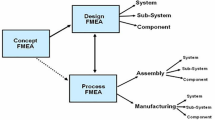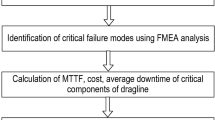Abstract
Performance of mechanical systems over their life cycle is the main concern of users. Original equipment manufacturers (OEMs) of such systems are made to deliver customized products with documented support to meet the objective. The product support is of various kinds, one of these is operation and maintenance (O&M) support. Cost incurred for each support action adds to the system life cycle cost (LCC) and therefore, a trade-off between O&M support, operational objectives and design characteristics is required to optimize the LCC. In this paper, important issues are identified for O&M support of mechanical systems and steps are proposed. Mathematical models are developed to assess the support objectives i.e. LCC and operational availability of the system. The LCC takes into accounts the acquisition cost and discounted sum of support activity cost, which consist of operating cost, inspection, corrective, preventive, overhaul and logistic cost. The proposed methodology has been implemented on a real life problem, in which the OEM provides O&M support to their compressors, installed at compressed natural gas workstation in national capital region, India. The results shows that a vital saving can be made in system’s LCC, when the support has been optimized in context to preventive maintenance, viz: age based at system level, while group maintenance based on optimum replacement interval and components’ scale parameter of their failure distribution. The sensitivity analysis validated the robustness of the solution methodology and the obtained results. This work will be helpful to OEMs, customers, academician, researchers, industrialists, and other concerned persons, in understanding the importance, severity and benefits obtained by the application and implementation of the O&M support.



Similar content being viewed by others
Abbreviations
- a:
-
Restoration factor
- A:
-
Operational availability
- Caq :
-
Acquisition cost of a system
- \( \,{\text{C}}_{{{\text{C}}_{\text{i}} }} \) :
-
Cost of ith subassembly within the system
- Cfix :
-
Fixed cost to perform each corrective or preventive action, which includes the cost of material required like lubricating oil, etc.
- CfixOH :
-
Fixed cost to perform the overhaul that includes the cost of material required like lubricating oil, etc.
- CfixI :
-
Fixed cost associated with every inspection action
- d:
-
Discount rate per annum
- Di :
-
Demand of ith subassembly per annum
- dij :
-
Distance from demand location i to a candidate site j
- E[CCA]:
-
Expected cost of corrective action during any investigation period for a system
- E[Ch]:
-
Expected cost of holding the spares during any investigation period for a system
- E[CIA]:
-
Expected cost of inspection during any investigation period for a system
- E[CL]:
-
Expected logistics cost during any investigation period for a system
- \( {\text{E}}\left[ {{\text{C}}_{\text{OH}} } \right] \) :
-
Expected cost of overhauls during any investigation period for a system
- \( {\text{E}}\left[ {{\text{C}}_{\text{op}} } \right] \) :
-
Expected operation cost during any investigation period for a system
- E[CPA]:
-
Expected cost of preventive action during any investigation period for a system
- E[CT]:
-
Expected cost of transportation of spares during any investigation period for a system
- E[NCAi]:
-
Expected number of corrective action of ith subassembly in the system
- E[NIi]:
-
Expected number of inspection of ith subassembly in the system
- E[NOHi]:
-
Expected number of overhauls of ith subassembly in the system
- E[NPAi]:
-
Expected number of preventive action of ith subassembly in the system
- E[ST]:
-
Expected cost of O&M support during any investigation period for a system
- E[TDT]:
-
Expected downtime for which the system is not available
- L:
-
Operating life of the system, in years
- Lc :
-
Labour cost per unit time
- LPCA :
-
Lost of average sales of product per unit time, during the uneven breakdown or failures
- LPPA :
-
Lost of average sales of product per unit time due to preventive actions
- m:
-
Support activities during a planned operating period
- MTTCAi :
-
Mean time to perform the corrective action on ith subassembly of the system
- MTTIi :
-
Mean time to perform inspection on ith subassembly of the system
- MTTOHi :
-
Mean time to perform overhauls on ith subassembly of the system
- MTTPAi :
-
Mean time to perform the preventive action on ith subassembly of the system
- N(t/V):
-
Conditional number of failure
- O:
-
No. of operators required for operating the system
- Oc :
-
Overhead cost per unit demand
- P:
-
Profit generated per unit of product sold
- Pt:
-
Preventive maintenance schedule
- PVc:
-
Present value of LCC
- RL :
-
Revenue lost due to maintenance actions
- S:
-
Salary of one operator per day
- Sc :
-
Storage cost per unit
- SSC :
-
Supervisory staff cost per unit
- T:
-
Total time
- Topr :
-
Actual operating time
- ti :
-
Inspection interval for ith subassembly of the system
- tOHi :
-
Overhaul interval for ith subassembly of the system
- tpmi :
-
Preventive maintenance interval for ith subassembly of the system
- V n :
-
Virtual age of the unit at the time of the nth repair completion
- V(n−1)i :
-
Virtual age of the component before carrying out a particular maintenance action
- X n :
-
Preventive maintenance interval
- Y:
-
Required level of availability
- αi :
-
Cost per unit distance per unit demand
- β:
-
Shape factor, defines the shape of distribution in Weibull
- η:
-
Scale parameter, defines where the bulk of the distribution lies in Weibull
References
Asjad M, Kulkarni MS, Gandhi OP (2012) A conceptual framework for analysing, improving and optimising supportability of mechanical systems. Int J Strateg Eng Asset Manag 1(2):135–152
Barabady J, Kumar U (2007) Availability allocation through importance measures. Int J Qual Reliab Manag 24(6):643–657
Barlow RE, Hunter LC (1960) Optimum preventive maintenance policies. Oper Res 8:90–100
Beichelt F (1993) A unifying treatment of replacement policies with minimal repair. Nav Res Logist 40:51–67
Blanchard BS (2006) Logistics engineering and management, 6th edn. Prentice-Hall India Private Limited, New Delhi, pp 465–495
Das K, Lashkari RS, Sengupta S (2007) Machine reliability and preventive maintenance planning for cellular manufacturing systems. Eur J Oper Res 183:162–180
Goffin K (1999) Customer support a cross-industry study of distribution channels and strategies. Int J Phys Distrib Logist Manag 29(6):374–397
Hatch M, Badinelli RD (1999) A concurrent optimization methodology for concurrent engineering. IEEE Trans Eng Manag 46(1):72–86
Hull DL, Cox JF (1994) The field service function in the electronics industry: providing a link between customers and production/marketing. Int J Prod Econ 37(1):115–126
Jones JA, Warrington L (2010) Generic approach for deriving reliability and maintenance requirements through consideration of in-context customer objectives. J Risk Reliab 224:105–112
Kijima M (1989) Some results for repairable systems with general repair. J Appl Probab 26:89–102
Knezevic J (1993) Reliability, maintainability, and supportability: a probabilistic approach. McGraw-Hill, New York
Lad BK, Kulkarni MS (2012) Optimal maintenance schedule decisions for machine tools considering the user’s cost structure. Int J Prod Res 50(20):5859–5871
Markeset T, Kumar U (2003) Design and development of product support and maintenance concepts for industrial systems. J Qual Maint Eng 9(4):376–392
Morse PM (1958) Queues, inventories, and maintenance. Wiley, New York
Nakagawa T (2008) Advanced reliability models and maintenance policies. Springer-Verlag Limited, London
Pham H, Wang H (1996) Imperfect maintenance. Eur J Oper Res 94:425–438
Scarf PA, Dwight R, Al-Musrati A (2005) On reliability criteria and the implied cost of failure for a maintained component. Reliab Eng Syst Saf 89(2):199–207
Sheu S-H (1998) A generalized age and block replacement of a system subject to shocks. Eur J Oper Res 108(2):345–362
Sheu S-H, Chien Y-H (2004) Optimal age-replacement policy of a system subject to shocks with random lead-time. Eur J Oper Res 159(1):132–144
Wang H (2002) A survey of maintenance policies of deteriorating systems. Eur J Oper Res 139(3):469–489
Wang H, Pham H (2006) Reliability and optimal maintenance. Springer-Verlag London Limited, London
Acknowledgments
We are thankful to the M/S Burckhardt Compression Limited, Pune, Maharashtra (India), for agreeing to jointly work with us in this research study. We express our heartfelt appreciation of Mr. Sanjay Pathak, Mr. Vinod Sharma and Mr. R. K. Sachdeva, of Burckhardt Compression Limited, for sharing their experience with us.
Author information
Authors and Affiliations
Corresponding author
Rights and permissions
About this article
Cite this article
Asjad, M., Kulkarni, M.S. & Gandhi, O.P. A life cycle cost based approach of O&M support for mechanical systems. Int J Syst Assur Eng Manag 4, 159–172 (2013). https://doi.org/10.1007/s13198-013-0156-7
Received:
Revised:
Published:
Issue Date:
DOI: https://doi.org/10.1007/s13198-013-0156-7




